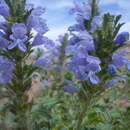Comments
provided by eFloras
Source of an essential oil, sometimes cultivated.
- license
- cc-by-nc-sa-3.0
- copyright
- Missouri Botanical Garden, 4344 Shaw Boulevard, St. Louis, MO, 63110 USA
Description
provided by eFloras
Herbs annual. Stems numerous, (6-)22-40 cm, erect or ascending, minutely retrorse hairy, purplish. Basal cauline leaves withering early; petiole as long as blade, shorter upward; leaf blade ovate-triangular, base cordate, margin remotely crenate, apex rounded; upper blades lanceolate to linear-lanceolate, 1.4-4 × 0.4-1.2 cm, yellow glandular, veins sparsely minute hairy, base rounded to broadly cuneate, margin triangular-dentate or sparsely serrate, with basal teeth sometimes lobelike, apex long spiny, obtuse. Verticillasters 4-flowered, loose, in 5-12 upper nodes of stems and branches; bracts oblong, shorter to slightly longer than calyx, margin 2- or 3-spinescent-denticulate, with spines 2.5-3.5 mm, sparsely appressed hairy. Pedicel 3-5 mm, horizontal after anthesis. Calyx 8-10 mm, golden glandular, pubescent especially basally, purple veined, 2-lipped to 1/2 its length; upper lip teeth divisions 1/4-1/3 of lip, teeth subequal, triangular-ovate, apex acute. Corolla bluish purple, 1.5-2.5 (-3) cm, dilated beyond throat, white pubescent outside; upper lip short navicular, ca. 1/4 as long as tube; middle lobe of lower lip dark purple spotted. Nutlets oblong, ca. 2.5 mm, apex truncate, smooth.
- license
- cc-by-nc-sa-3.0
- copyright
- Missouri Botanical Garden, 4344 Shaw Boulevard, St. Louis, MO, 63110 USA
Distribution
provided by eFloras
Gansu, Hebei, Heilongjiang, Henan, Jilin, Liaoning, Nei Mongol, Qinghai, Shaanxi, Shanxi [India, Russia, Tajikistan, Turkmenistan; Europe]
- license
- cc-by-nc-sa-3.0
- copyright
- Missouri Botanical Garden, 4344 Shaw Boulevard, St. Louis, MO, 63110 USA
Habitat
provided by eFloras
Dry hills, stony riverbanks, valleys; 200-2700 m.
- license
- cc-by-nc-sa-3.0
- copyright
- Missouri Botanical Garden, 4344 Shaw Boulevard, St. Louis, MO, 63110 USA
Cultivation
provided by EOL authors
In the second half of the 16th century, D. moldavica was introduced to Europe and cultivated as ornamental, spice, medicinal and bee plant [1, 2]
In Mexico D. moldavica is systematically cultivated. [3]
Dracocephalum moldavica: Brief Summary
provided by wikipedia EN
Dracocephalum moldavica, the Moldavian dragonhead, is an annual herbaceous plant. The first formal botanical description of D. moldavica was by Linnaeus in Species Plantarum 2:595. 1753.
- license
- cc-by-sa-3.0
- copyright
- Wikipedia authors and editors

